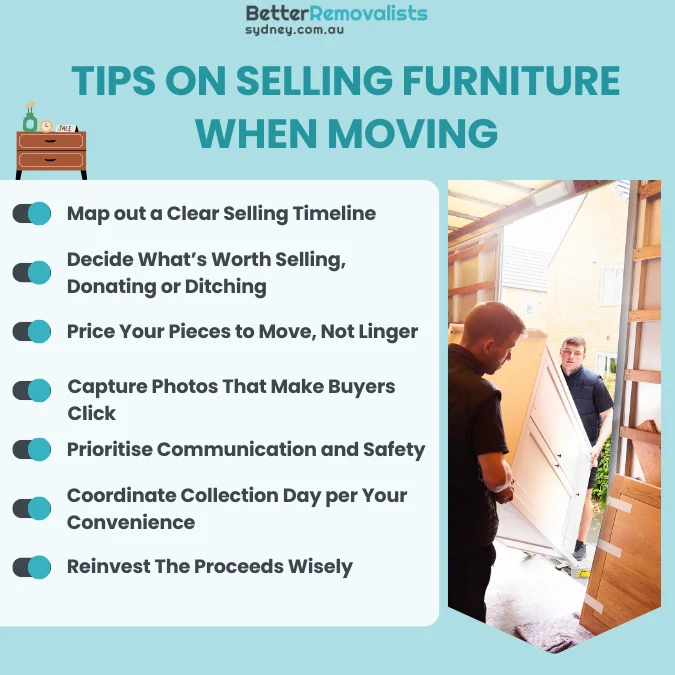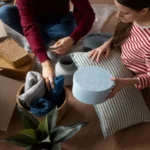Want to pack or move your belongings like professionals? Read our blog posts that will help you manage relocation process with ease.


Dumping your sofa on the curb and hoping someone takes it? Not ideal. Accepting pennies for a “like new” bed frame on a resale app? Even worse. Selling household furniture when moving is a challenge many face, but with the right strategies, it can be a simpler and more profitable affair. If you’re wondering how to sell your unwanted furniture, while still honouring its value and your memories, worry not. This guide will help.
There is a smarter way to sell your furniture without having to deal with underselling, time wastage and flakey buyers who only beat around the bush. This piece will lead you through a step by step approach for effectively selling your furniture before moving. Furthermore, by arranging your sales with the help of professional removalists Sydney, you can keep your move on schedule, and avoid any last minute delays or surprises. Let us plunge in, guys.
Hide
Show
Time is your most valuable asset when it comes to moving, so work backwards from your scheduled departure date. Note down 4 key milestones to achieve:
Starting 6 to 8 weeks ahead, allows premium furniture pieces like sofa, dining set and designer sideboards, to attract the right buyers. Smaller items like stools, lamps or bookshelves shift quickly, so list those closer to moving week. A staggered timeline stops your home from turning into a warehouse of half packed boxes, lets you field enquiries in manageable waves and keeps money flowing in well before moving costs fall due.

Not every item deserves to be a listing. Begin with a brutal, liberating audit. Ask yourself three questions: Is it in good structural condition? Is the replacement cot higher than the freight cost? Does it suit the climate and decor of your new home? A bulky chipboard wardrobe that costs $150 new is rarely worth trucking interstate; a solid timber chest may fetch double that on Gumtree.
Well loved pieces that no longer fit your style can be passed onto friends, family or charity. Anything wobbly, mould ridden or unsafe belongs in the rubbish heap or for a council trash pickup. By filtering ruthlessly, you focus your efforts on high value pieces that will genuinely boost the relocation budget.
Australian Buyers are savvy and a quick search shows them exactly what similar items have sold for. Research completed listing – rather than active ads – on Marketplace and eBay to find real world numbers. As a rule of thumb price your pieces at 50 to 70% of their current retail if your item is under three years old and in near new condition; drop to 30 to 40 % for older or lightly scuffed pieces.
Be transparent. Mention the original RRP, brand, timber species, upholstery fabric or any custom features that justify your price. Consider putting in sweeteners like “price firm but includes local delivery within 10kms” to stand out from the crowd. Lastly, build in a small negotiation buffer – Australians love a respectful haggle, and closing a deal $20 less is better than relisting for weeks.
A good photo of your product can make a lot of difference. Shoot in daylight with curtains open and overheads off to avoid any harsh shadows. Stage the piece well. Clear clutter, remove personal items and if possible, dress the space with a plant or throw to suggest scale. Start with a full frame front view picture, then add side angles, close ups of textures, maker’s mark and any imperfections. Five to eight images will give buyers confidence and bump your listing higher in algorithmic feeds.
If the item can be disassembled, then include a shot of the dismantled parts; apartment dwellers will thank you for it. Quality photos not only show that you have cared for the furniture, and signal you’ll be an honest, organised seller, especially if you’re coordinating handovers with punctual Removalists Sydney who always maintain schedules.
Where you list your furniture matters a lot. Facebook Marketplace and Gumtree are good for everyday items like sofas, beds, dining sets, etc. But for designer pieces, antique sideboards or collectible mid century chairs, Facebook Groups, Instagram pages or Australian auction sites like Leonard Joel or Shapiro work better.
For ultra contemporary items, consider consignment via a local boutique that takes a commission for showroom floor space. Wherever you list, include dimensions in centimetres (depth, width, height) and specify the pickup suburb. Reply to enquiries quickly, as the interest of buyers starts to cool fast when messages sit unanswered overnight.
Once offers roll in, move the conversations to a single thread (messenger or text) to avoid missing details. Confirm everything clearly like the price, pickup time and how the buyer will be paying for the item. It’s best to meet them outside if you can, like on your front porch or in the garage, to avoid strangers from wandering through your home. Avoid giving out your full address too early.
If the item is heavy, see if the buyer can bring a mate to help or if needed, book in professional removalists Sydney that homeowners often rely on. It’s a good option if you want peace of mind and less risk of anything getting damaged or someone accidentally hurting themselves.
Set pickup times that suit your schedule. Allocate a Saturday morning window for big items that need two people and a Ute, then smaller after work slots for decor or bedside tables. Label each piece clearly with masking tape bearing the buyer’s name; keep a running checklist to tick off payments received.
If you’ve booked removalists, ask whether they offer a short “hand off” service – loading sold items directly onto the buyer’s vehicle or your moving truck if the purchaser can meet you onsite. This ensures your schedule runs on time and both parties enjoy a streamlined, damage free exchange.
With cash in hand, resist the urge to splurge on last minute takeaways and petrol station coffees. Maintain a spreadsheet tracking sales income against the moving costs like hiring bond cleaners, packing supplies, truck hires and connection fees. By treating sales revenue as part of the relocation budget, you prevent nasty shocks on the other side and start a life in the new place on solid financial footing.

Selling household furniture ahead of the moving date does not need to turn into a headache. With an organised timeline, realistic pricing, strong visuals and clear communication, you can convert yesterday’s decor into today’s moving fund while ensuring handover is safe and stress free. Happy Moving and Selling!



